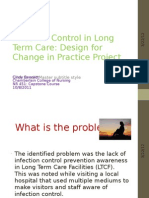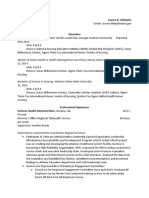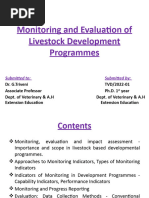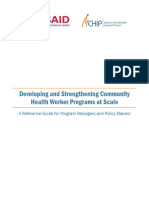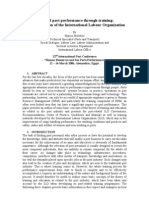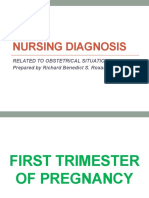How Does Program Monitoring (Reading 1 and 2) Fit Into The Schematic Diagram of The Function of Program Evaluation Given in Figure?
How Does Program Monitoring (Reading 1 and 2) Fit Into The Schematic Diagram of The Function of Program Evaluation Given in Figure?
Uploaded by
Noti GelzCopyright:
Available Formats
How Does Program Monitoring (Reading 1 and 2) Fit Into The Schematic Diagram of The Function of Program Evaluation Given in Figure?
How Does Program Monitoring (Reading 1 and 2) Fit Into The Schematic Diagram of The Function of Program Evaluation Given in Figure?
Uploaded by
Noti GelzOriginal Title
Copyright
Available Formats
Share this document
Did you find this document useful?
Is this content inappropriate?
Copyright:
Available Formats
How Does Program Monitoring (Reading 1 and 2) Fit Into The Schematic Diagram of The Function of Program Evaluation Given in Figure?
How Does Program Monitoring (Reading 1 and 2) Fit Into The Schematic Diagram of The Function of Program Evaluation Given in Figure?
Uploaded by
Noti GelzCopyright:
Available Formats
1.
How does program monitoring (reading 1 and 2) fit into the schematic diagram of the function of program evaluation given in figure? 1. 1 Monitoring and evaluation of a large-scale community-based program: Recommendations for overcoming barriers to structured implementation fitted into the schematic diagram of the function of Program evaluation. This reading provided an outline of a Home Visiting Program (HVT) and its aim includes: a) integrate home visiting into existing antenatal and postnatal services, b) contribute to improving the integration and coordination of antenatal and postnatal services in the region and c) provide a home visiting service by nurses and volunteers that enhances the infants growth and (physical, emotional, social and cognitive) development and support the wellbeing of the parents and other family members. On the other hand, this program is under monitoring and evaluation. The aim is to employ a systematic and objective method for describing and reviewing the program structure, including staffing and referral arrangement; program implementation; information on program participants; intervention range-the focus and nature of the interventions undertaken with clients during home visits ; short term impact; and selected client outcomes. In the planning phase of the program, the local community needs are initially identified. In this paper, health services and resources are the needs. The government made an initiative to access disadvantaged families in the community through funding the HVP. There are also other professional groups (team of community health nurses, public health researches) that helped in the monitoring and evaluation of the program. The target special group of this program includes the disadvantaged families outside current service networks and improve linkages between services in a socially and economically deprived urban area of New South Wales, Australia. The program was specifically designed to assist at risk pregnant women, parents and their families. In this paper, ongoing evaluation of the program was observed from the planning part to the results of the service. In each part of the process, it was made sure that the program has been implemented as planned. 1.2 The Program Evaluation and Monitoring System: A Key Source of Data for Monitoring Evidence Based HIV Prevention Program Processes and Outcomes, fits the program
monitoring the schematic diagram in the sense that it is continuous evaluation and that it is holistic in nature. Local community needs which is HIV prevention or reduction of cases of HIV, the governmental agencies which is the CDC Division of HIV/AIDS Prevention (DHAP), Professional groups like doctors and nurses, and special interest groups will now form a plan to reduce or prevent HIV cases which will then become an HIV Prevention Program that will be funded by the CDC DHAP. Based from the program, there will be a Program Evaluation and Monitoring System of the HIV Prevention Program. This Program Monitoring will evaluate the effectiveness of the program implemented and will determine future plans as how to proceed because evaluation is ongoing throughout the process of HIV Prevention Program. It will also provide feedbacks of the strengths and weaknesses of the HIV Prevention Program. Basically the Program evaluation will be the check and balance of the entire operation to check for every aspect of the HIV Prevention Program.
2. Develop an information system for each of the programs monitored in Reading 1 and 2 based a.) relevant information b.) actual state of the program c.) program participants d.) providers of services. Reading 1 a.)Relevant Information Interventions rendered by the HVP nurses. Quality and outcome of home visiting services provided by the HVP nurses. Variables such as breastfeeding rates and duration, childhood immunisation rates, social support, mothers psychological well-being, knowledge and use of community services, and smoking rates. b.) Actual state of the program The eligibility criteria and referral pathways for admission into the HVP were not clearly defined. The program expanded beyond its target population, accepting clients who required professional expertise not offered by the program and consequently the evaluation reflected an
inaccurate level of program inadequacy. The level of need and complexity of issues experienced by families were much greater than HVP staff anticipated, despite previous experience in the locality. The program was under-resourced for the degree of need experienced by its clients. The role of the team and the activities they undertook continued to evolve in response to the observed and expressed needs of their clients. Variation between, and sometimes within, individual staffs recording of activities decreased inter-rater reliability and reduced data consistency. The action research model adopted required that the evaluation, especially the data forms, be periodically amended in response to the operation of the program. Some HVP staff did not accept the responsibility of completing the data forms, citing clients needs as a more urgent task. The introduction and compulsory use of a new information system (CHIME) for all community health facilities within the organization. Follow-up of very mobile clients who have a transient lifestyle. The true effectiveness of the program was diffi cult to assess; longterm outcomes could not be measured. Organisations or groups inappropriately withdrew support to a family when the HVT became involved. c.) Program Participants There were 118 clients (families within the communities which were outside current service networks.) These comprises at risk pregnant women, parents and there family members.
d.) Providers of services A team of community health nurses, part-time nurses and volunteers.
Reading 2 a. Relevant Information: The CDC has undertaken major efforts to ensure that its funded HIV prevention programs are effective in preventing the spread of HIV. CDC strategies to improve HIV prevention efforts include reducing barriers to HIV testing; strengthening prevention efforts and linkages to medical treatment and care for HIV infected persons; delivering targeted,
evidencebased HIV prevention interventions to atrisk populations; and improving organizational capacity to monitor and evaluate prevention programs. Such strategies have been incorporated into program guidance and cooperative agreements between the CDC and health departments and communitybased organizations funded to deliver or support HIV prevention programs. The CDC has identified, developed, and endorsed HIV prevention programs that have demonstrated evidence of effectiveness either through research projects, demonstration projects, or research reviews and syntheses. These include the CDCdeveloped guidelines for HIV counseling, testing, and referral and for partner counseling and referral services (CDC, 1998, 2001), the Compendium of HIV Prevention Interventions with Evidence of Effectiveness for Populations at High Risk (CDC, 1999, revised 2001) findings from systematic reviews (Lyles, Kay, Crepaz, Herbst, Passin, Kim et al., in press), the Procedural Guidance for Selected Strategies and Interventions for CommunityBased Organizations Funded under Program Announcement 04064 (CDC, 2003b), and the intervention kits produced by the Replicating Effective Programs (REP; Sogolow, Kay, Doll, Neumann, et al., 2000) project and disseminated and supported by the Diffusion of Effective Behavioral Interventions (DEBI) project (CDC, 2004a). b. Actual State of the Program: Before the development of the Program Evaluation and Monitoring System (PEMS), grantees performance in HIV prevention was limited by the lack of a standardized set of HIV prevention variables and adequate data collection systems for managing and reporting such data. With no standardized data collection system in place, data reported to the CDC were often incomplete, of questionable quality, and not comparable across agencies or program areas. PEMS is a national data reporting system developed to strengthen the capacity to monitor and evaluate CDC-funded HIV prevention programs administered by the Division of HIV AIDS Prevention (DHAP). c. Program Participants: Grantees of CDC-funded HIV prevention programs administered by the Division of HIV and Aids Prevention from across the US
d. Provider of the Service: Centers for Disease Control and Prevention (CDC) Division of HIV/AIDS Prevention (DHAP)
3. Explain how monitoring relates to formative and summative evaluations. Monitoring programs is a means of evaluating programs. There are two types of evaluation in terms of instructional design and these are formative and summative evaluation. A formative evaluation (sometimes referred to as internal) is a method for judging the worth of a program while the program activities are forming (in progress). This part of the evaluation focuses on the process. A summative evaluation (sometimes referred to as external) is a method of judging the worth of a program at the end of the program activities (summation). The focus is on the outcome. Monitoring is the crucial aspect or program evaluation whether it is formative evaluation or summative evaluation for it is essential to keep track of activities. In evaluation using program monitoring it includes the assessment of the resources devoted to the program and whether this effort is directed as planned. You can monitor through formative which means the focus of monitoring is on the process and it can be done before or during a projects implementation with the aim of improving the projects design and performance. In order to know whether or not you are on track to achieving your programs objectives, you must monitor the project during implementation as well as evaluate its impact at the end of the project. Monitoring the progress of the project allows you to adapt the program as needed to ensure that you attain your objectives.
You might also like
- Clinical Gynaecology: Juta - Co.za/pdf/23698Document3 pagesClinical Gynaecology: Juta - Co.za/pdf/23698Thato Motaung0% (1)
- 02 PTW Risk AssessmentDocument5 pages02 PTW Risk Assessmenttoocoolforamailid100% (1)
- Pharmacology Clear and Simple A Guide To Drug Classifications and Dosage Calculations 2nd Edition Watkins Solutions ManualDocument4 pagesPharmacology Clear and Simple A Guide To Drug Classifications and Dosage Calculations 2nd Edition Watkins Solutions ManualJamesJoFrancis100% (1)
- Trauma Triad of DeathDocument5 pagesTrauma Triad of DeathTomNo ratings yet
- NR451 - PPT - Presentation Infection Control in Long Term CareDocument22 pagesNR451 - PPT - Presentation Infection Control in Long Term CareAndrea Tyler100% (1)
- Flow Chart - Prisoner Re-Entry ProgramDocument7 pagesFlow Chart - Prisoner Re-Entry ProgramUrbanistRuralsNo ratings yet
- Monitoring, Evaluating, and Improving: An Evidence-Based Approach to Achieving Development Results that Matter!From EverandMonitoring, Evaluating, and Improving: An Evidence-Based Approach to Achieving Development Results that Matter!No ratings yet
- Rhetorical Analysis Essay FinalDocument5 pagesRhetorical Analysis Essay Finalapi-363883917No ratings yet
- Philippine Childhood Immunization Schedule 2019Document8 pagesPhilippine Childhood Immunization Schedule 2019Linius Cruz67% (3)
- Harris Hip ScoreDocument2 pagesHarris Hip ScoreEma Abrudan100% (2)
- Case Study 9 - Simon (Chronic Schizophrenia)Document6 pagesCase Study 9 - Simon (Chronic Schizophrenia)Vonn GalangNo ratings yet
- H PyloriDocument117 pagesH PyloriRE_INVESTOR100% (4)
- Community Health ProgramDocument43 pagesCommunity Health ProgramBsoom .iNo ratings yet
- Eval GuideDocument92 pagesEval GuideJason BrownNo ratings yet
- Introduction To Program Eval Pub HealthDocument18 pagesIntroduction To Program Eval Pub HealthmonikaNo ratings yet
- Logic Models For Planning EvaluationDocument21 pagesLogic Models For Planning EvaluationAji HandokoNo ratings yet
- Manual 04062006Document135 pagesManual 04062006Moustapha Salem MansourNo ratings yet
- APBHP PlanningDocument6 pagesAPBHP Planningmarcamille100% (1)
- NCM 113 CHN Ii LPDocument5 pagesNCM 113 CHN Ii LPChristine UdhayNo ratings yet
- Running Head: PROGRAM EVALUATION 1Document9 pagesRunning Head: PROGRAM EVALUATION 1Sidra UsmanNo ratings yet
- CHN 12Document20 pagesCHN 12kisb.almazar.auNo ratings yet
- Monitoring and EvaluationDocument82 pagesMonitoring and EvaluationMarata0232100% (4)
- Drsarwat - 3087 - 20371 - 2 - Lecture 3b. Health Service Planning ProcessDocument20 pagesDrsarwat - 3087 - 20371 - 2 - Lecture 3b. Health Service Planning ProcessAazeen memonNo ratings yet
- NURSING FOUNDATIO1 ASSINMENT 02Document19 pagesNURSING FOUNDATIO1 ASSINMENT 02SAROJ KUMARNo ratings yet
- Monitoring and Evaluation ToolsDocument53 pagesMonitoring and Evaluation ToolsJunu Hada100% (1)
- NCM 113 Midterm Lec Mod 6Document10 pagesNCM 113 Midterm Lec Mod 6Angel Khrisna BacasmotNo ratings yet
- Realities of Replication: Implementation of Evidence-Based Interventions For HIV Prevention in Real-World SettingsDocument9 pagesRealities of Replication: Implementation of Evidence-Based Interventions For HIV Prevention in Real-World SettingsCesar Antonio Vargas AlayzaNo ratings yet
- Planning and EvaluationDocument28 pagesPlanning and Evaluationvdtjqm8y4nNo ratings yet
- CDC Eval ManualDocument103 pagesCDC Eval ManualMihaiisvoranuNo ratings yet
- AHMA ZSPH RJ 15jun26Document4 pagesAHMA ZSPH RJ 15jun26David John Dumajel AranasNo ratings yet
- Health Planning in IndiaDocument47 pagesHealth Planning in Indiadevendra singhNo ratings yet
- M&E Fundamentals - A Self-Guided Mini-CourseDocument55 pagesM&E Fundamentals - A Self-Guided Mini-CourseJoseph PeraltaNo ratings yet
- Monitoring HIV-AIDS Programs (Participant) - Module 7Document9 pagesMonitoring HIV-AIDS Programs (Participant) - Module 7Yuga MasayuNo ratings yet
- Me FundamentalsDocument89 pagesMe FundamentalsalicorpanaoNo ratings yet
- The Harm Reduction Education ProgramDocument19 pagesThe Harm Reduction Education ProgramTyler PNo ratings yet
- Situation 15. The Community Health Nurse Prepares/participate in The Preparation of TheDocument3 pagesSituation 15. The Community Health Nurse Prepares/participate in The Preparation of TheJœnríčk AzueloNo ratings yet
- Health Education Lesson 5Document5 pagesHealth Education Lesson 5marionchepkirui63No ratings yet
- Equity and Monitoring Progress of The NSHDP in Nigeria - The PHC Reviews by DR Eboreime EjemaiDocument34 pagesEquity and Monitoring Progress of The NSHDP in Nigeria - The PHC Reviews by DR Eboreime EjemaiEjemai EboreimeNo ratings yet
- ToRs SHM Zvandiri Endline EvaluationDocument6 pagesToRs SHM Zvandiri Endline Evaluationraymondkaridza5No ratings yet
- Project Proposal Fund To Improve Child Healht Care, Education and NiturationDocument60 pagesProject Proposal Fund To Improve Child Healht Care, Education and NiturationTesfaye DegefaNo ratings yet
- Seminar MiesDocument16 pagesSeminar Mieshannahashok0% (1)
- Handwashing Promotion Monitoring & Evaluation ModuleDocument9 pagesHandwashing Promotion Monitoring & Evaluation ModuleGlobal Public-Private Partnership for HandwashingNo ratings yet
- Phublic Health Managment Case StudyDocument9 pagesPhublic Health Managment Case Studyousmandb2No ratings yet
- 1.6 ME PlanDocument15 pages1.6 ME PlanleulsjournalNo ratings yet
- T Evaluation Research PolicyDocument4 pagesT Evaluation Research PolicyRick ThomaNo ratings yet
- Infection Control Program in The HospitalDocument14 pagesInfection Control Program in The HospitalLorelie Asis100% (2)
- Planning To Reach Every CommunityDocument37 pagesPlanning To Reach Every Communityzedregga2No ratings yet
- M&EFrameworkDocument40 pagesM&EFrameworkdiazabba1No ratings yet
- Lauren B. LittlejohnDocument16 pagesLauren B. Littlejohnapi-516216369No ratings yet
- MS 07 20Document82 pagesMS 07 20Ko Phyo WaiNo ratings yet
- A UNICEF Guide For Monitoring and Evaluation - Making A Difference PDFDocument92 pagesA UNICEF Guide For Monitoring and Evaluation - Making A Difference PDFTony Frank RomeoNo ratings yet
- GRP Guidelines On Health Promotion Evaluation enDocument16 pagesGRP Guidelines On Health Promotion Evaluation enTri SubiantoroNo ratings yet
- Solved Questions NSC 504Document10 pagesSolved Questions NSC 504Aminu IdrisNo ratings yet
- Guidance and Counseling 201Document27 pagesGuidance and Counseling 201STEPHEN MILANNo ratings yet
- Action Against Hunger - 2016 - Multi-Sectorial Monitoring & Evaluation. A Practical Guide For FieldworkersDocument167 pagesAction Against Hunger - 2016 - Multi-Sectorial Monitoring & Evaluation. A Practical Guide For FieldworkersGael LopezNo ratings yet
- Unit - 1Document65 pagesUnit - 1urstruly mithunNo ratings yet
- Understanding PHC Reviews and The Nigeria Planning and Implementation Framework - DR Eboreime EjemaiDocument34 pagesUnderstanding PHC Reviews and The Nigeria Planning and Implementation Framework - DR Eboreime EjemaiEjemai EboreimeNo ratings yet
- Lecture File 1Document21 pagesLecture File 1BSN2G- SABLA-ON LORRAINE ANNENo ratings yet
- Developing and Strengthening CHW Programs at ScaleDocument386 pagesDeveloping and Strengthening CHW Programs at Scalelychandy1986No ratings yet
- National Dengue Prevention and Control Program: A Policy Impact AnalysisDocument9 pagesNational Dengue Prevention and Control Program: A Policy Impact AnalysisblairNo ratings yet
- Eval PlanningDocument9 pagesEval PlanningShivendra SinghNo ratings yet
- Beyond Accountability Sussma LentferDocument19 pagesBeyond Accountability Sussma LentferCyra SyedNo ratings yet
- Osborne+et+al +the+health+education+impact+questionnaireDocument10 pagesOsborne+et+al +the+health+education+impact+questionnairesandrine.abellarNo ratings yet
- Health Management Plan DR Ajeh 610Document29 pagesHealth Management Plan DR Ajeh 610chelseapasiahNo ratings yet
- A Clinician’s Guide to HCV Treatment in the Primary Care Setting: A Multimedia eHealth Source™ Educational InitiativeFrom EverandA Clinician’s Guide to HCV Treatment in the Primary Care Setting: A Multimedia eHealth Source™ Educational InitiativeNo ratings yet
- Comprehensive Care Coordination for Chronically Ill AdultsFrom EverandComprehensive Care Coordination for Chronically Ill AdultsCheryl SchraederNo ratings yet
- Violence Against Women and Girls: Effectiveness of Intervention Programs: Gender Equality, #3From EverandViolence Against Women and Girls: Effectiveness of Intervention Programs: Gender Equality, #3No ratings yet
- Primary Biliary Cholangitis: A High-Yield Guide to PBC Management in the Era of PPAR AgonistsFrom EverandPrimary Biliary Cholangitis: A High-Yield Guide to PBC Management in the Era of PPAR AgonistsNo ratings yet
- Soap HamilDocument5 pagesSoap Hamilusnal.4iniNo ratings yet
- Advocacy PaperDocument3 pagesAdvocacy Paperapi-478583234No ratings yet
- Medicare Module 1 Program Basics Download PDFDocument62 pagesMedicare Module 1 Program Basics Download PDFjohndeleon0100% (1)
- Analysis of Anatomical and Functional Determinants of Obstructive Sleep ApneaDocument9 pagesAnalysis of Anatomical and Functional Determinants of Obstructive Sleep ApneaFifi RetiatyNo ratings yet
- Occupational StressDocument164 pagesOccupational Stressraluka120100% (7)
- ILO TrainingDocument19 pagesILO TrainingpauljayakarNo ratings yet
- SCMS v31 No3 Mobile AppsDocument9 pagesSCMS v31 No3 Mobile AppspawanNo ratings yet
- Thomas Orthodontics: Patient InformationDocument2 pagesThomas Orthodontics: Patient InformationChris EvamsNo ratings yet
- Hospital and Doc List PDFDocument17 pagesHospital and Doc List PDFmanunair13No ratings yet
- Jcaho 2003 National Patient Safety GoalsDocument13 pagesJcaho 2003 National Patient Safety GoalsJefferson ButalidNo ratings yet
- Disability Tax Credit InstructionsDocument12 pagesDisability Tax Credit InstructionsShauna PaynterNo ratings yet
- Classroom Instructional Delivery Alignment Map For JHS: (Based On AMT/RBT Classification)Document5 pagesClassroom Instructional Delivery Alignment Map For JHS: (Based On AMT/RBT Classification)Queenie GamboaNo ratings yet
- Literature Review of College BuildingDocument5 pagesLiterature Review of College Buildingea428adh100% (1)
- RobinDocument3 pagesRobinRobin RiturbanNo ratings yet
- Psychiatric Mental Health Nursing Question PDF DownloadDocument2 pagesPsychiatric Mental Health Nursing Question PDF DownloadCharles Obaleagbon100% (1)
- Gerontechnology For Serving Needs and Ambitions of Older AdultsDocument24 pagesGerontechnology For Serving Needs and Ambitions of Older Adultsjimvo87No ratings yet
- 1543 2742 Article p428Document6 pages1543 2742 Article p428Jorge Rubio LopezNo ratings yet
- Symptoms: SyphilisDocument5 pagesSymptoms: SyphilisknotstmNo ratings yet
- Examiners Report NEBOSH IGC2 March April 2014Document9 pagesExaminers Report NEBOSH IGC2 March April 2014AnhNo ratings yet
- Nursing Diagnosis: Related To Obstetrical Situations Prepared by Richard Benedict S. Roxas, RN, MDDocument26 pagesNursing Diagnosis: Related To Obstetrical Situations Prepared by Richard Benedict S. Roxas, RN, MDRichard S. RoxasNo ratings yet
- Tuberculosis (TB) Presentation PDFDocument12 pagesTuberculosis (TB) Presentation PDFUday GuptaNo ratings yet




